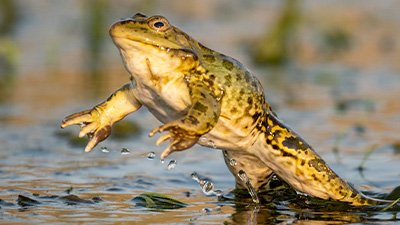Super-Sticky Spit: How a Frog Gets a Meal
You’ve probably never thought much about how frogs manage to eat insects, spiders, birds, mice, fish, and even other frogs in the blink of an eye. In fact, you may not have even known they ate such a medley of food. But a frog’s ability to grab and eat such a variety of food—and so quickly—is a testament to the creativity of the Designer.
Scraping Frog Tongues for Science
Frogs have the incredible ability to catch and eat a wide variety of prey, from hairy to furry to oddly-shaped. This prey can be up to 1.4 times their own body weight. A recent study published in Journal of the Royal Society Interface sought to figure out how frogs can accomplish this since not much research had been done previously.1 Their findings were summed up in an article from Science News.2
After viewing slow-motion video footage, conducting experiments, and analyzing frog spit (it took several hours of scraping fifteen frog tongues to put together enough spit for just one test. Now who says science isn’t glamorous?), researchers discovered that the frog’s super-soft tongue and unique saliva work in tandem.
Super-Soft Tongues and Super-Sticky Spit
Frogs strike at prey in the blink of an eye. Actually, five times faster than the blink of an eye! But their tongues aren’t just lightning fast, they’re super soft (think marshmallow soft). When the tongue launches and hits the intended target, it “splats on impact,” which allows it to curl and surround the prey. The tongue acts like a car’s shock absorber, “absorbing energy and so preventing separation from the insect.”
And that’s just the beginning. The frog’s spit then comes into play. As the frog’s tongue leaves its mouth, the saliva is very viscous (thick like honey) and sticky. When the tongue splats onto the intended target, the saliva changes to a thinner liquid, allowing it to flow over a textured surface. The tongue then retracts into the frog’s mouth, and the saliva thickens again, securely holding the prey despite that “during that tongue jerk, acceleration can surge to 12 times the pull of Earth’s gravity.” The unique nature of the spit and the “soft stretchiness of the tongue, a natural bungee cord that retracts without too much of a jolt,” ensures the frog gets lunch. And all this happens in a fifth of the time it takes you to blink.
It’s in the Eyeballs
But now what? The frog’s food is stuck to its tongue, how is it going to eat it? The frog’s eyeballs sink into its head, which pushes the food down its throat. The energy from their eyeballs forces the saliva into a liquid state yet again, freeing the prey and giving the frog a tasty (well, to him anyway) meal.
This video from Tech Insider sums up the research, including slow-motion videos of frogs chowing down. Video by Alexis Noel/Georgia Tech
Can Slow and Gradual Processes Explain How a Frog Gets Dinner?
Next time you see a frog sitting idly, waiting for lunch, stop and marvel at its incredible design. Multiple parts must be working together to ensure this frog gets a meal. In addition to everything already discussed, there’s also the role of the eyes in seeing food, the brain and nervous system in responding accurately to the sight of food, and the legs in propelling the frog toward the food. But, ignoring those additional needs, let’s just look at the tongue and spit from an evolutionary perspective (the perspective of the researchers).
A super-soft tongue won’t be of any use without the extra-sticky saliva. The tongue may wrap around the prey, but it can’t hold it there without the saliva. But the saliva can’t just be super sticky—it must be able to change forms or else it’s useless. But what if the tongue has the unique saliva, but not the super-soft tongue? Well, the researchers say “replacing the frog tongue with a stiffer human tongue would result in an 80% decrease in contact area.” So that frog won’t be getting much for dinner. You need all of the parts working together to ensure the successful capture of prey. The slow accumulation of traits won’t help this hungry amphibian. He needs everything at once.
The Creator Clearly Seen, Even in Spit
In their study, the researchers note that “there is no known commercial mechanism that can match the grabbing speed of the frog tongue, let alone adhere to a highly textured surface like a fly.” Humans, with all our intelligence, research, and collaboration, can’t come close to what the frog can do effortlessly. Shouldn’t this make us conclude that there is intelligence behind the frog’s design?
As the Apostle Paul puts it in Romans, “For since the creation of the world His invisible attributes are clearly seen, being understood by the things that are made, even His eternal power and Godhead, so that they are without excuse” (Romans 1:20). God is clearly seen in what He has made—even in frog spit.
Footnotes
- Alexis C. Noel et al., “Frogs Use a Viscoelastic Tongue and Non-Newtonian Saliva to Catch Prey,” Journal of the Royal Society Interface, 14, no. 127 (February 2017): doi:10.1098/rsif.2016.0764.
- Susan Milius, “What Gives Frog Tongues the Gift of Grab,” Science News, January 31, 2017, https://www.sciencenews.org/article/what-gives-frog-tongues-gift-grab.

Answers in Genesis is an apologetics ministry, dedicated to helping Christians defend their faith and proclaim the good news of Jesus Christ.
- Customer Service 800.778.3390
- © 2024 Answers in Genesis




